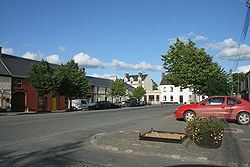Time zone WET (UTC+0) Elevation 380 m | Irish Grid Reference R9761087713 Local time Tuesday 3:19 PM | |
 | ||
Weather 9°C, Wind S at 18 km/h, 87% Humidity | ||
a november day at the ecovillage cloughjordan s eco neighbourhood
Cloughjordan, officially Cloghjordan (/klɒkˈdʒɔːrdən/ klok-JOR-dən, Irish: Cloch Shiurdáin, meaning "Siurdán's stone"), is a town in County Tipperary in Ireland. It is in the barony of Ormond Lower, and it is also a parish in the Roman Catholic Diocese of Killaloe.
Contents
- a november day at the ecovillage cloughjordan s eco neighbourhood
- Map of Cloughjordan Co Tipperary Ireland
- About the house cloughjordan eco village 2009
- History
- Transport
- Education
- Sport
- People
- Buildings of note
- Recent developments
- Festivals
- Awards
- References
Map of Cloughjordan, Co. Tipperary, Ireland
The town is situated in the north-western part of Tipperary close to the Offaly border. It is almost equidistant from Nenagh, Roscrea and Birr and is close to Ireland's largest river, the Shannon, and Lough Derg.
Poet and patriot Thomas MacDonagh, a native of Cloughjordan, described it as a place "in calm of middle country".
Unusually for a town of its size (the 2002 Census Records places the population at 431), it has three churches – Roman Catholic (SS Michael and John's, built in 1898), Church of Ireland (St Kieran's, 1837) and Methodist (1875).
Cloughjordan is in the Dáil constituency of Offaly which incorporates 24 electoral divisions that were previously in the Tipperary North Dáil constituency.
About the house cloughjordan eco village 2009
History
Developed at the intersection of travel routes between Nenagh, Birr, Borrisokane and Moneygall, the village of Cloughjordan began as an inhabited settlement during the Norman lordship of Ireland of the 13th and 14th centuries when the De Marisco family were allotted land in Ormond under the overlordship of the Butlers by King Henry II. One unit of the De Mariscos (Morris or Morrissey in modern terms) moved into this area, took over the territory and built a stone castle and manor house guarded by a moat surrounding the dwelling.
There is a story which relates that the first De Marisco, who resided here, was a Norman knight who had travelled to the Holy Land to take part in a Crusade against the Saracen invaders. He is said to have brought back a stone from the River Jordan which he built in over the doorway of this castle and it was from that stone that the village got its name – the Stone of Jordan – Clogh Shiúrdáin – Cloughjordan.
Cloughjordan was further developed in the late 17th century by Cromwellian grantees when Colonel John Harrison, an officer in Cromwell's army, was granted an estate of 1,484 acres (6.01 km2) of land around Cloughjordan in payment for his military services. Harrison built a house, now known as Cloughjordan House, at the site of the original Norman Castle of De Marisco and incorporated the old castle into the new building, in which one wall of the castle, about seven and a half feet thick, is still in existence to this day.
Cloughjordan was then remodelled in the late 18th century to include a square in front of the Church of Ireland on the east-west main street.
In 1909 Cloughjordan was one of the first villages in Ireland, after Carlow and Birr, to provide its own rural electrification scheme. The ESB took over the supplying of electricity to the town in 1948.
Transport
Cloughjordan railway station opened on 5 October 1863. It is on the Limerick–Ballybrophy railway line, at Ballybrophy it joins the main Dublin-Cork railway line.
A January 2012 national newspaper article suggested that Iarnród Éireann was expected to seek permission from the National Transport Authority to close the line however an enhanced timetable was in force on a trial basis during 2012. The service was again reduced from February 2013.
Ken Daly Bus Hire operates limited minibus services between Cloughjordan and Birr, Nenagh and Roscrea. Each return service operates once a week.
Education
Historically, Cloughjordan National School opened in 1876. Its first teachers were Joseph and Mary Louise MacDonagh, parents of Thomas MacDonagh, succeeded by Denis Costello, father of Michael Joe Costello. Nowadays, Cloughjordan children have crèche and primary schooling but as yet no secondary school in the town.
First Steps childcare centre opened in 2010 offering crèche and preschool facilities in the former Macra na Feirme hall on Lower Main Street. Kilruane has a Montessori pre-school. There are two primary schools in Cloughjordan: Number One School is located on Templemore Road, east of the town centre and Number Two School is located on Lower Main Street, west of the town centre.
There is no secondary education provision in the town: local students travel to schools in neighbouring Nenagh, Borrisokane and Birr or further afield.
The eco-village has a working group known as the Village Education Research and Training (VERT), which is committed to running courses based in the eco-village encouraging best practice in sustainable living.
Also with a base in the eco-village is Cultivate, an organisation committed to sustainable living and learning.
Sport
People
Buildings of note
There are several buildings of architectural interest in and around Cloughjordan.
Recent developments
Festivals
Cloughjordan Festival is an annual celebration of art, sport, music and food held each summer in various venues around the village.
Cloughtoberfest, a celebration of both Gypsy Jazz and Irish craft brewing took place each October from 2011 to 2015.
A Thomas MacDonagh Week-end was held in May 2014, one year after the opening of the Thomas MacDonagh Heritage Centre. It is hoped that this celebration of Cloughjordan's connection with MacDonagh will become an annual event.
Awards
In 2012, 2013 and 2014 Cloughjordan won the National Green Community Award.
